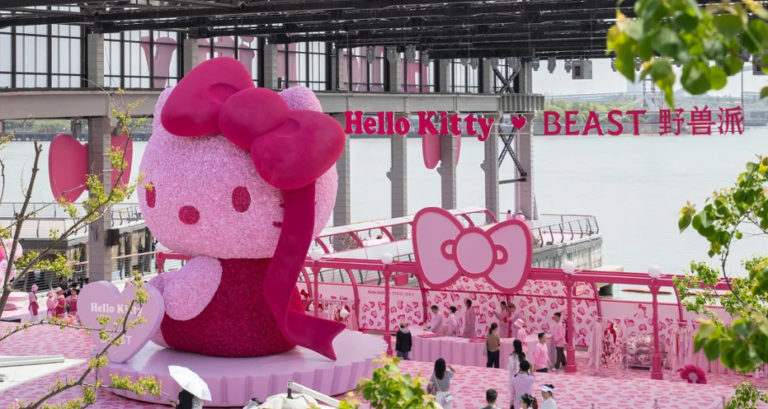In China, luxury co-branding is not just a trend; it’s an innovation powerhouse that is reshaping the market with unexpected and often surprising partnerships. Far beyond conventional alliances, these collaborations bring together brands from dramatically different sectors – from local food and beverage giants to fashion brands (like the collaboration between Fendi and HEYTEA), and even into the eclectic worlds of anime, comics, games, and novels.
Download our China luxury market report
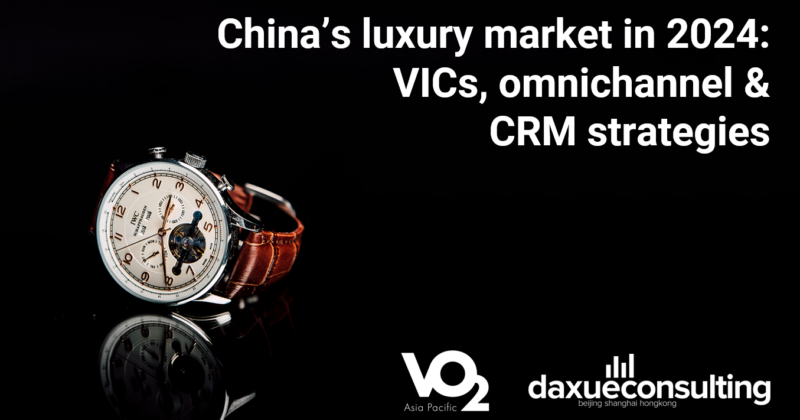
According to the statistics from 2021, more than 80% of brands collaborated with another brand on a co-branded product or campaign at least once. This phenomenon is more than just a blend of logos; it’s about creating something novel and captivating that challenges the norms of branding. It’s this adventurous spirit and the pursuit of uniqueness that make co-branding especially popular and successful in the Chinese luxury market.
In this article, we’ll dive into the reasons behind the surge in co-branding, and the various creative forms it takes, and highlight some of the most intriguing and successful campaigns that have sparked consumer interest and admiration.
What is Co-Branding?
Co-branding is a marketing strategy where two or more brands collaborate to create a product or service that combines their strengths and appeals to a wider audience. This approach allows brands to leverage each other’s reputation and customer base, creating unique offerings that stand out in the market.

Why is co-branding such a popular marketing strategy in the Chinese market?
In China, co-branding began to gain popularity in the 1990s. The nation’s rapid economic growth and the rise of a consumer culture open to new and innovative brand collaborations fuelled this trend. Brands, both local and international, saw this as an opportunity to explore creative partnerships and connect with Chinese consumers in novel ways.
With time, the forms of cooperative marketing evolved, developing from simple product-bundled sales to co-branding of various forms. Luxury local and international brands engage in co-branding collaborations to infuse their offerings with additional layers of exclusivity and uniqueness. Unlike mass-market brands, luxury brands thrive on maintaining a certain allure and rarity that resonates with their high-end clientele.
By partnering with other luxury entities or selectively with non-luxury brands that offer a certain cachet or cultural significance (and have an entirely different or the same target audience), luxury brands can craft limited-edition products and experiences that can’t be easily replicated. This not only reinforces their brand visibility and image but also creates a buzz that can attract both existing luxury consumers and aspirational customers. Compared with fighting alone, a co-branding initiative can beat competitors and grab a larger market share. It has a mutually beneficial and win-win result.
The win-win strategy to grab a larger market share
Apart from the reasons mentioned above, co-branding is a win-win situation for all engaged parties, helping in areas such as branding, consumer acquisition and product development;
Raising perceived brand value
Luxury brands embody prestige and high value, making them attractive partners for collaborations. When other brands team up with luxury names, their main goal is often to elevate their own brand image by associating with the luxury brand’s esteemed reputation. This strategy not only boosts their perceived value but also opens doors to a more upscale audience, enriching their brand story with elements of luxury, craftsmanship, and exclusivity.
Re-shaping brand image
Luxury brands, through collaboration, can weave in their partners’ fresh perspectives, such as youthful energy or a deep-rooted understanding of Chinese cultural nuances, enriching their brand narrative and broadening appeal.
Showcasing brand values
Co-branding can highlight values like sustainability, charity, and cultural heritage, which resonate well in markets such as China, offering brands a platform to align with meaningful causes and deepen consumer engagement.
Gaining validity in a new market
Co-branding is not only for well-known brands. A good co-branding cooperation with a reputable brand can greatly kick-start a new brand in the Chinese market.
Tapping into a new consumer base
Luxury brands often engage in co-branding collaborations ‘out of their comfort zone’, meaning that they are trying to reach new audiences by gaining awareness among their partner’s consumers/audience. This is why many luxury brands collaborate with young Key Opinion Leaders, video games etc.
Expanding services provided
Rather than expanding their offerings by adding new services in-house, brands can strategically form partnerships with organizations that are already experts in those areas. This approach allows brands to broaden their portfolio and enhance customer value without the need for significant internal investment or development, tapping into the established expertise and infrastructure of their partners.
Injecting inspiration into R&D
Collaborating on product development can inject new ideas into research and development processes, leading to innovative, limited-edition designs that stand out in the market.

Different Types of Co-Branding Methods Often Used by Luxury Brands
In recent years luxury brands have been finding new and intriguing collaboration methods and co-branding strategies, winning audiences with unique, often controversial approaches to marketing and branding. There are many methods currently used by brands, and some of the ones used the most by luxury brands in China include:
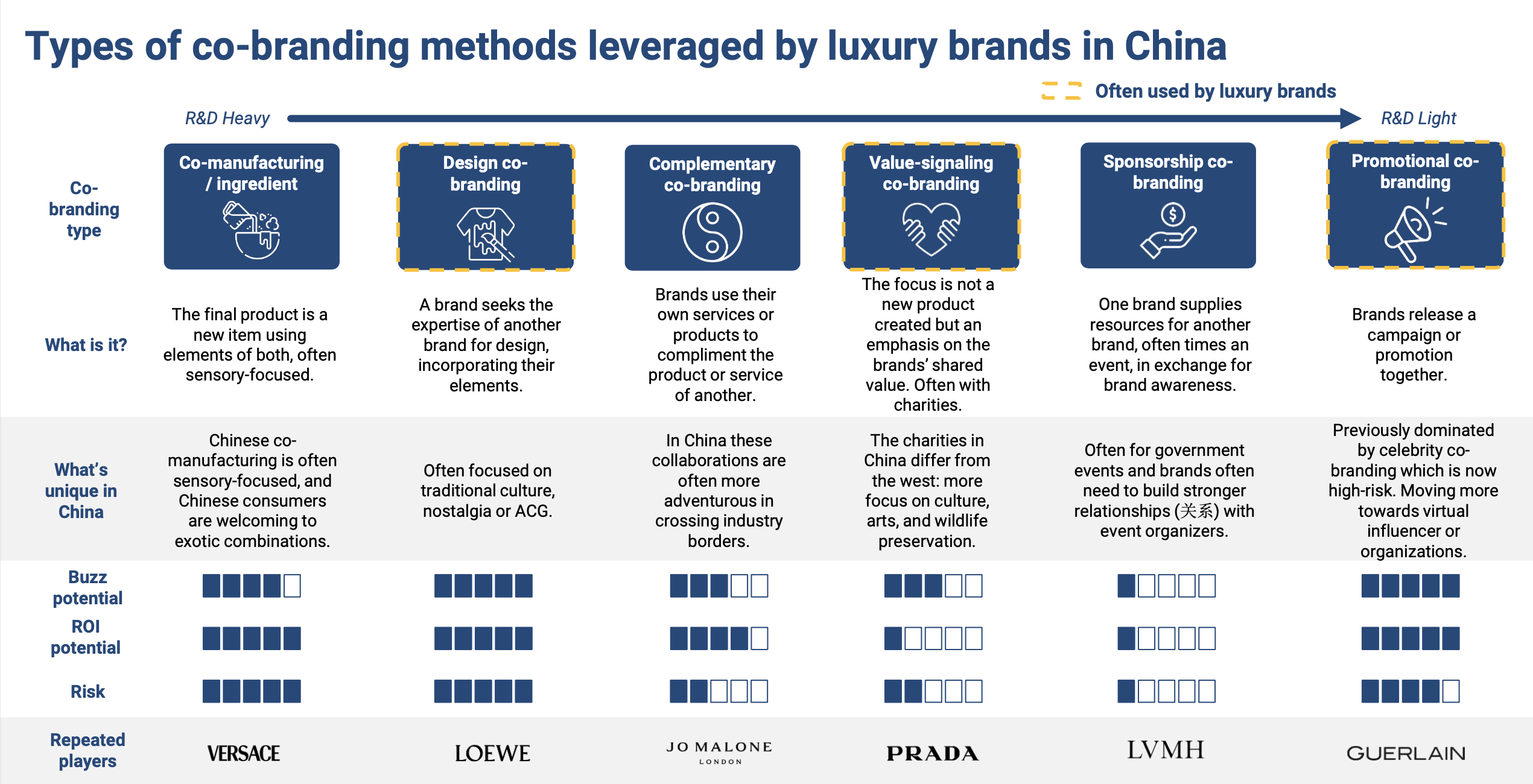
Co manufacturing
The final product of such a co-branding strategy is a new item that uses elements from both brands. Usually, those exciting co-branded products are very sensory-focused, especially in China, where consumers are very welcoming to exotic combinations.
This type of co-branding requires a more complicated research and development process, but it has a high buzz and ROI potential. Yet, with such an investment of time and resources, there also comes a big risk, so it’s important to thoroughly research the market and prepare for the campaign with the co-branding partner.
Co-manufacturing was leveraged by Valentino in a recent collaboration with Venchi and Cova. Valentino was promoting its iconic pink PP colour through collaborations with Cova, offering a Pink PP-themed afternoon tea set exclusively at its Plaza 66 store in Shanghai, and with Vinchi for a Pink PP-themed pitaya-flavoured ice cream available at 43 boutiques in China.
The campaign was a huge success, resulting in over 162,000 views of the #SweetVCollab hashtag on Weibo. Valentino crafted an exclusive and limited-time experience through a cross-category collaboration, providing a unique and premium offering, which raised the brand’s perceived value among the Chinese audience.
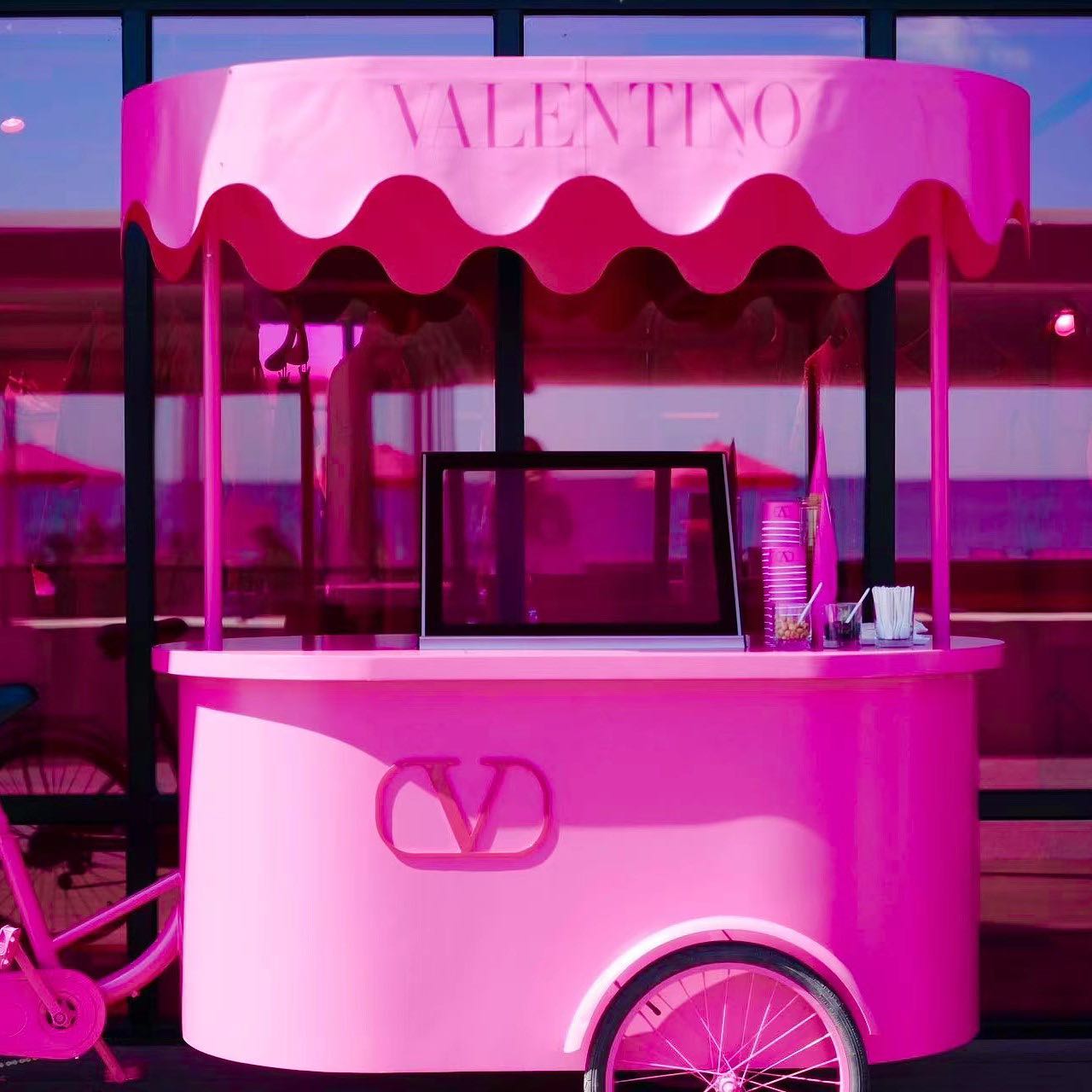

Inspired by Valentino’s signature “pitaya pink,” Venchi crafted a new gelato flavor in the natural hues of pitaya, source: Facebook
Design co-branding
This type of co-branding is very popular in all kinds of brands, starting from fashion, through anime, and furniture, to food and drinks. A brand interested in creating a unique product seeks the expertise of another brand for design, incorporating its elements or techniques. In China, this type of co-branding is often centred around traditional culture, nostalgia or ACG.
Design co-branding is another more elaborate and complicated co-branding method, it comes with great risk but is also the most rewarding in terms of buzz and ROI potential. Design co-branding is one of the most favoured co-branding strategies by luxury brands in China.
One of the great examples of this method was a loud collaboration between Louis Vuitton, Manner, Metal Hands and PlusOne. LV opened three pop-up bookstores in collaboration with local Chinese brands; Manner, Metal Hands and PlusOne, where each store featured a unique colored theme.
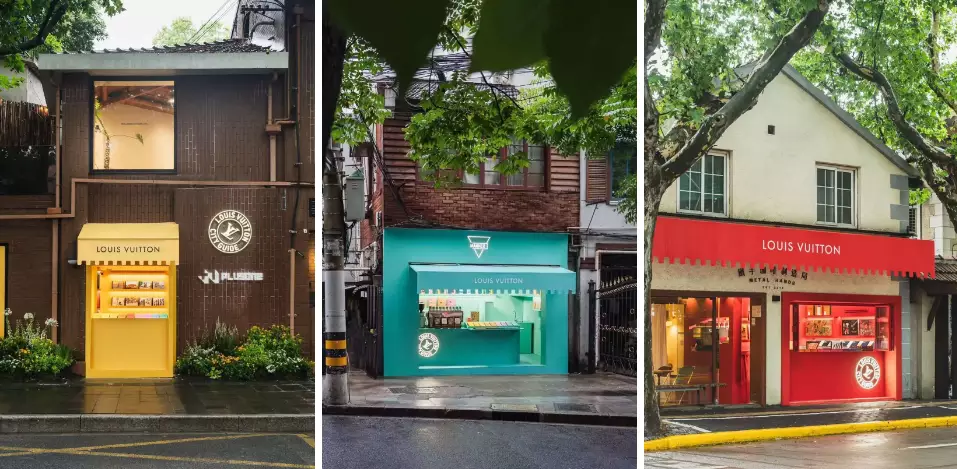
The campaign sparked a collectibles craze among Chinese consumers, offering a complimentary Canvas bag exclusively with the purchase of at least 2 LV city guides, each starting at RMB 290. The hashtag #LVShanghaiBookstoreCanvasBag garnered 140M views on Weibo.
The whole campaign helped Louis Vuitton reshape its brand image, enhancing its association with lifestyle and consumer engagement. The brand also tapped into a new consumer base, creating a craving for the brand among middle-income Gen Z consumers, extending beyond the high-income demographics.
Complementary co-branding
In this method, brands use their services or products to complement the product or service of another. In China, these collaborations are often more adventurous in crossing industry borders.
Complementary co-branding is not as risky as co-manufacturing and design co-branding, it also involves lower R&D effort but has a smaller buzz potential, yet often brings good ROI.
Value signalling co-branding
In value signaling co-branding the focus is not a new product created but an emphasis on the brands’ shared value. This type of co-branding method is often used with charities, which differ in form from the West; they are more focused on culture, arts, and wildlife preservation.
This method is low in risk, but also has a very low ROI potential, with slightly better BUZZ potential. Yet, is one of the methods most often used by luxury brands in China.
One such collaboration was carried out by Louis Vuitton with the Shanghai lifestyle. The brand’s “Nóng Hó, Shanghai” pop-up at Fotografiska Shanghai Museum (Oct 12 to Nov 12) embodied the city’s culture with curated collections, including the latest LV City Guide Shanghai edition.

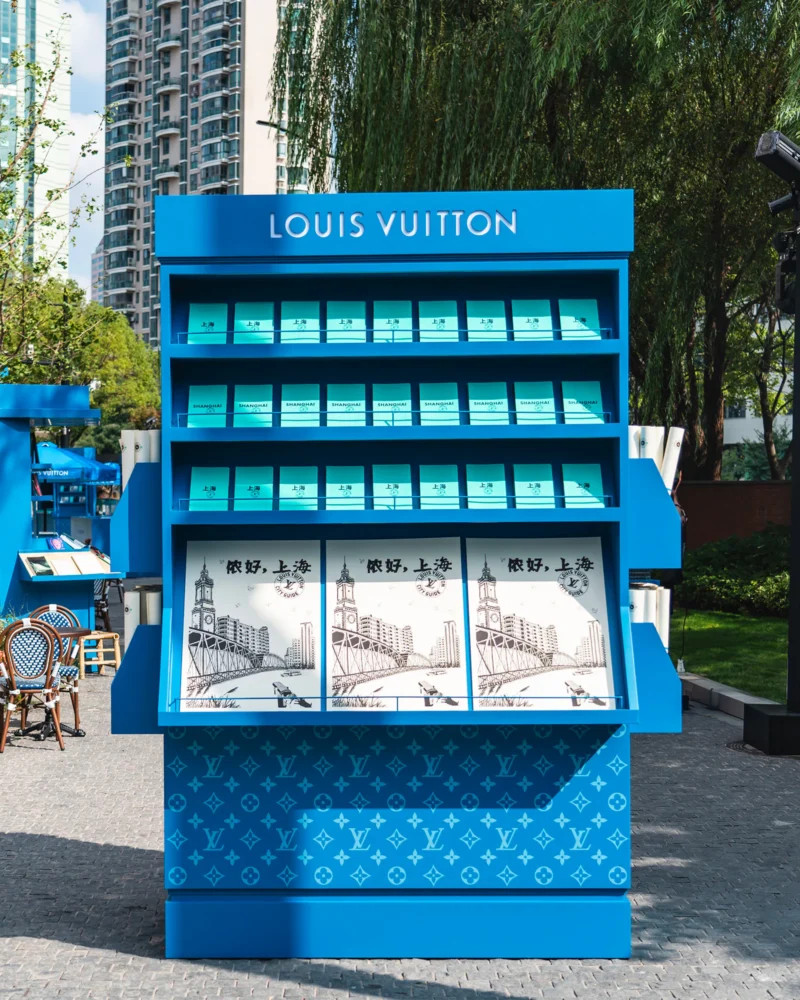
The event, named in the local dialect, captured the essence of being Shanghainese, attracting many young Chinese consumers with this strategic collaboration. Source: Louis Vuitton
Throughout the month-long event, LV engaged audiences through offline activities, such as book clubs, cultural talks, and children’s workshops. Concurrently, the brand introduced its first Chinese podcast series, “Louis Vuitton [EXTENDED],” on Xiaoyuzhou (小宇宙), exploring topics like Shanghainese street breakfast and the transformation of the Suzhou River area.
The campaign helped reshape the brand image by positioning LV as not just a luxury fashion label but also a cultural and lifestyle curator. It was also a great way to showcase brand value, deepening LV’s ties with Shanghai luxury consumers and redefining the essence of being Shanghainese. It generated a very high buzz on media and social media, engaging a lot of consumers, and at the same time being very low in risks involved.
Sponsorship co-branding
Sponsorship co-branding happens when one brand supplies resources for another brand, oftentimes an event, in exchange for brand awareness. This situation often happens with government events and brands need to build stronger relationships with event organizers.
Promotional co-branding
Promotional co-branding campaigns happen very often, as it’s a win-win situation for both brands, who release a campaign or promotion together, benefiting from each other’s buzz.
When it comes to China, promotional co-branding previously was dominated by celebrity co-branding which is now high-risk due to many celebrity and influencer scandals in recent years. Today, luxury brands are moving towards virtual influencers and organizations.
Promotional co-branding is one of the most favoured methods by luxury brands, as it has a big buzz and ROI potential and a smaller risk and R&D involved, in comparison to co-manufacturing and design co-branding.
Into the co-branding hype:
- Luxury co-branding in China involves innovative partnerships across diverse sectors, including fashion and ACG.
- Over 80% of brands have participated in co-branding, driven by a quest for uniqueness and popularity in the luxury market.
- Co-branding benefits include enhanced branding, expanded consumer reach, and creative product development.
- Collaborations allow brands to combine strengths, increasing perceived value and injecting fresh perspectives.
- Co-branding emphasizes shared values like sustainability, appealing to consumers’ values.
- Various methods, from co-manufacturing to promotional co-branding, each present unique advantages and challenges.
- Successful campaigns, such as Valentino’s Pink PP-themed collaborations, demonstrate co-branding’s ability to transform brand images and attract new audiences.
Download Our China’s Luxury Market in 2024 Report
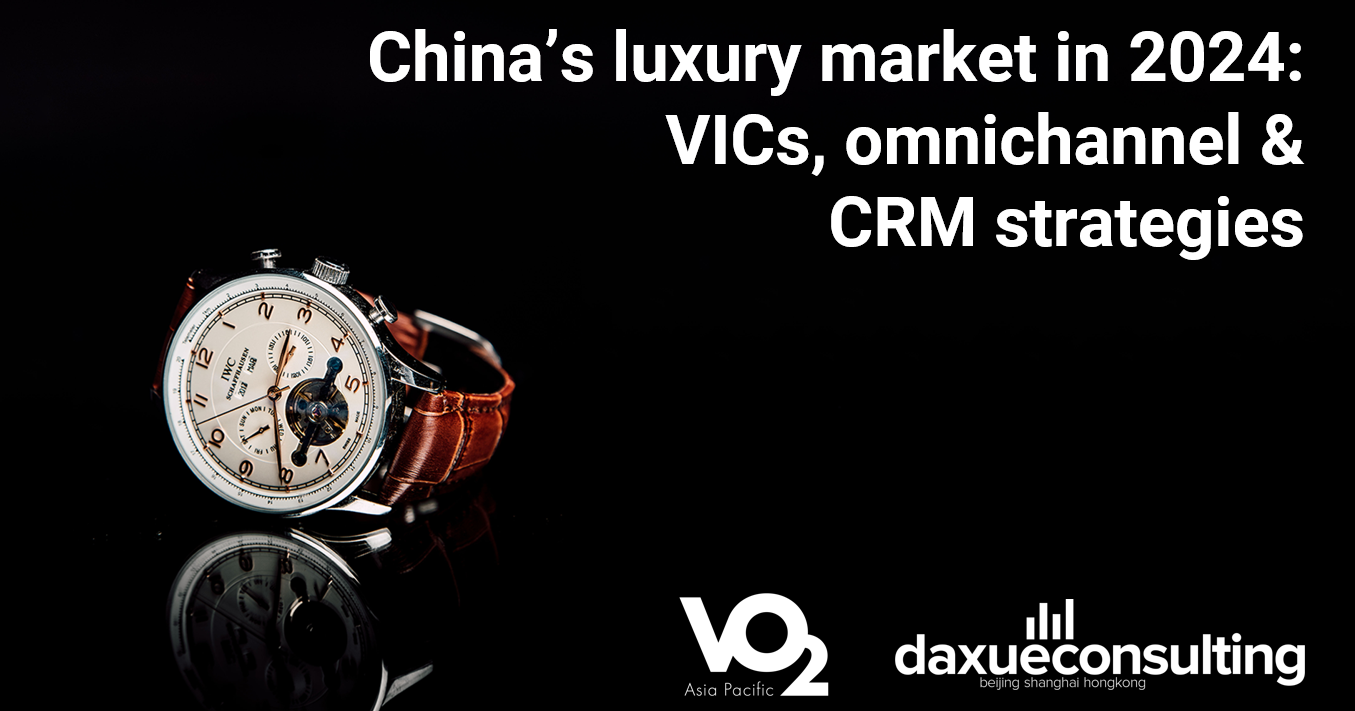
Together with VO2 Asia Pacific, Daxue Consulting team created an insightful report on the state of the luxury market in China in 2024. Inside, apart from co-branding techniques and examples of great co-branding collaboration from the recent year, we gathered the newest data and market insights on:
- The current state of China’s luxury market
- Trends and new challenges for luxury brands
- Omnichannel strategies used by brands in China
- CRM regulations and implementation in the luxury landscape
If you’re eager to explore further the co-branding topic or would like to deep-dive into China’s luxury market in 2024, download our report below:





